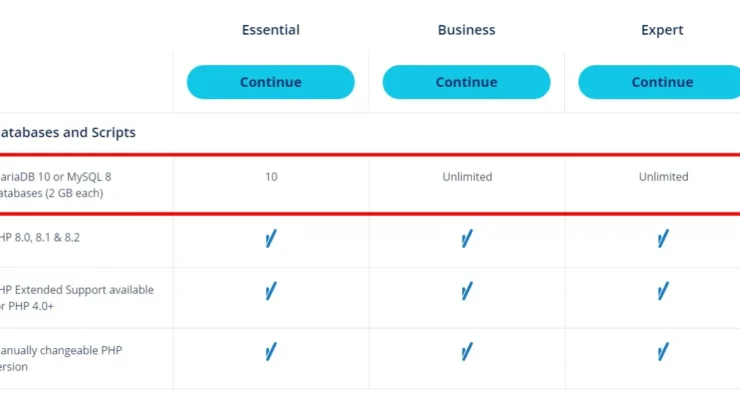
High-traffic websites, brimming with users and demanding instantaneous responses, rely heavily on robust database hosting solutions to perform at their best.
A website struggling to handle a surge in database queries can result in frustrating slowdowns, lost customers, and ultimately, lost revenue.
Choosing the right hosting provider for handling high database loads is crucial for online success, ensuring seamless user experiences and preventing operational bottlenecks.
This article delves into the critical aspects of selecting the optimal hosting for high db load, equipping you with the knowledge and insights necessary to maintain peak website performance.
This is no longer a niche concern; as e-commerce expands and online services become more intricate, handling escalating database loads is an absolute necessity for maintaining a quality user experience.
Ensuring seamless access to data and quick response times is paramount, requiring precise consideration of factors such as server architecture, scalability, and query optimization.
The key to achieving this lies in selecting a hosting solution that can accommodate exponential spikes in database traffic, and which can scale resources as required.
This comprehensive guide will illuminate the critical distinctions between various hosting options, enabling you to confidently select the best hosting for high db load solutions that align with your unique needs and budget.
Understanding these nuanced choices will differentiate your website from those that struggle during peak hours, and this empowers you to maintain an edge in a competitive online landscape.
Database Server Configuration for High Load
A robust database server architecture is fundamental to selecting the best hosting for high db load, directly impacting website performance under stress.
Optimizing database server configuration involves carefully balancing resource allocation to ensure responsiveness and stability even during peak usage periods.
This involves meticulously selecting hardware, such as CPUs, RAM, and storage, tailored to the anticipated database load.
Efficient database indexing strategies are crucial to minimize query response times and enhance overall application speed.
Properly configured caching mechanisms can significantly reduce the database load by storing frequently accessed data in memory.
Database server sizing and scaling strategies are essential for adapting to fluctuating traffic volumes without impacting performance.
Understanding the specific needs of your application and the potential maximum database query volume is vital for successful database server configuration.
Scaling strategies for databases should be proactive and include horizontal or vertical scaling options as required to meet growing data demands.
Choosing the right database management system (DBMS) with features like high availability and failover capabilities is essential for maintaining uptime.
A well-structured database schema, designed with efficiency and performance in mind, directly translates to faster query processing.
The selection of appropriate database server operating systems and versions, optimized for high load handling, is critical for performance.
Monitoring and analyzing database server metrics, such as query latency and resource utilization, helps identify potential bottlenecks.
Implementing proper database maintenance procedures, including regular backups and optimization routines, ensures data integrity and stable performance.
Continuous monitoring and proactive adjustments to the database server configuration are vital to maintain optimal performance and scalability for best hosting for high db load.
Careful consideration of database server configuration, coupled with an understanding of your application’s requirements, directly contributes to the selection of the best hosting environment for your specific needs. This is crucial for maintaining high performance under fluctuating load conditions.
Implementing these strategies for database server configuration will help ensure that your hosting solution can successfully handle high db load without compromising performance.
Database Server Configuration for High Load
A robust database server architecture is fundamental to selecting the best hosting for high db load, directly impacting website performance under stress.
Optimizing database server configuration involves meticulous resource allocation to ensure responsiveness and stability during peak usage.
The choice of hardware components significantly influences database performance, requiring careful consideration of CPU, RAM, and storage capacity.
Selecting a CPU with sufficient processing power for concurrent queries is crucial for handling high db load effectively. Adequate RAM allocation ensures smooth data retrieval and avoids performance bottlenecks.
High-performance storage solutions, such as SSDs, are essential for fast data access, which is vital for maintaining efficient database operations under high load.
Efficient indexing strategies directly impact query response times and the overall performance of applications requiring a high db load. Choosing appropriate indexes enhances speed by accelerating data retrieval.
Implementing caching strategies reduces the database load by storing frequently accessed data in memory, significantly improving response times. This technique is key to minimizing latency.
Strategies for sizing and scaling the database server are essential for accommodating fluctuating traffic volumes without jeopardizing performance.
Scaling the database server efficiently is often crucial. Vertical scaling, upgrading hardware, or horizontal scaling, distributing data across multiple servers, are strategies to consider based on predicted load.
Monitoring database server performance metrics, such as query latency and resource utilization, is critical for identifying and addressing potential bottlenecks and maintaining optimal performance under high db load conditions.
Proper database server configuration is not a one-time task. Ongoing monitoring and adjustments to settings are necessary to adapt to evolving needs and maintain exceptional performance for high db loads.
Careful configuration of the database server’s operating system and software ensures optimal resource utilization. This includes installing relevant database server software.
Utilizing appropriate database server software is critical. The correct choice depends on the specific database management system (DBMS) in use.
Understanding the specific needs of your application is crucial to select the right database server hardware and software configurations.
Employing database server tuning techniques can optimize performance further by fine-tuning parameters for query efficiency.
A well-designed database server architecture is a cornerstone of high-performing websites capable of handling heavy loads.
Database Optimization for High Load
A crucial component of choosing the best hosting for high database load is understanding and optimizing database performance.
Efficient database management is paramount to handling a high volume of data requests, ensuring responsiveness and preventing slowdowns or failures.
Optimizing database queries is key in reducing latency and maximizing throughput for hosting solutions under high DB load.
This involves careful consideration of query structure, indexing strategies, and appropriate database server configurations.
Poorly structured queries can significantly impact performance, leading to bottlenecks and sluggish response times for applications that rely heavily on data retrieval and manipulation.
Indexes, which provide rapid access to specific data within the database, are essential for high-performance database hosting.
Effective indexing strategies can dramatically reduce the time it takes to execute queries, contributing to a significant improvement in the overall system’s responsiveness during high database load.
The choice of database management system (DBMS) also heavily influences performance. Different DBMSs have varying strengths and weaknesses regarding query optimization and handling large datasets. Choosing a DBMS optimized for high transaction volumes and large datasets is essential for robust hosting.
Database administrators must understand database schemas and their impact on query performance and the overall hosting environment.
Moreover, database tuning, which involves fine-tuning the database server configuration, can improve efficiency and responsiveness. Proper database configuration, including appropriate caching mechanisms and resource allocation, is essential for high-performance hosting during peaks in database traffic.
Efficient hosting environments for high DB load require dedicated servers or scalable cloud resources to allocate sufficient processing power, memory, and storage to handle the anticipated workload.
Robust hosting solutions for high database load should also feature redundant systems, backups, and failover mechanisms to maintain uptime and protect against data loss. This includes high availability (HA) setups which ensure continuous operation even during hardware failures or maintenance activities.
Regular monitoring and tuning of the database server’s performance metrics are crucial to proactively identify and address potential bottlenecks before they impact application performance. Monitoring tools and alerts provide visibility into the system’s health and allow for timely intervention during high DB load conditions.
In essence, optimizing the database itself is a critical aspect of selecting the best hosting for high DB load. A well-structured database, with efficient queries, appropriate indexing, and optimized server configuration, will be crucial for handling large volumes of data effectively.
Scalability and Performance Under High Load
Scalability is paramount when choosing a hosting provider capable of handling high database loads, as it directly affects the performance and stability of your application.
A robust hosting solution must be designed to automatically adjust resources—CPU, RAM, and storage—to match the increasing demand placed on the database servers during peak usage.
This dynamic adjustment ensures that your application remains responsive even during periods of high traffic or database activity, preventing bottlenecks and slowdowns.
Effective hosting solutions for high database loads often employ various techniques to manage scalability, including horizontally scaling (adding more servers to the cluster) and vertically scaling (increasing the resources of individual servers). This strategy is crucial for maintaining optimal performance and uptime when dealing with peak database activity.
Efficient load balancing is also a key aspect of scalability, ensuring that the incoming traffic is distributed evenly across multiple servers in the hosting environment. This crucial functionality prevents overloading a single point of entry and maintains seamless access for all users during peak times, especially during surges in high database load.
The ability to handle spikes in database queries directly relates to the overall reliability and performance of the hosting platform. A hosting service that can gracefully scale up to meet these surges in demand is fundamental for applications dependent on a speedy and reliable database interaction, and contributes significantly to minimizing downtime and maintaining optimal user experience.
Implementing this scalable infrastructure is vital for hosting applications reliant on high volumes of database interaction, ensuring a smooth user experience and preventing costly downtime that may occur with a poorly-designed hosting solution. A well-architected high database load hosting solution should be adaptable, dynamic, and capable of consistently handling peak user demands without noticeable performance degradation.
In the realm of best hosting for high db load, scalability is not just a desirable feature; it’s a fundamental requirement for applications needing to handle database-intensive operations effectively.
Choosing the best hosting for high DB load is crucial for websites and applications that experience significant database activity.
This article highlighted the importance of factors like server hardware specifications, database management system (DBMS) support, scaling options, and robust infrastructure to handle the demands of a high volume of database requests effectively.
Whether it’s a news site with thousands of concurrent users or an e-commerce platform handling massive online orders, the right best hosting for high DB load can dramatically impact performance, user experience, and ultimately, success.
A poorly optimized hosting solution can lead to sluggish responses, downtime, and ultimately, a poor user experience. The consequences can range from lost sales to damage to brand reputation.
In conclusion, this comprehensive exploration of best hosting for high DB load underscores the pivotal role of reliable infrastructure in ensuring website stability, functionality, and scalability. By understanding the critical elements of robust hosting and making informed decisions about your choice, you can equip your project to handle high database load efficiently and effectively. Finding the right best hosting for high DB load solution allows businesses to scale their operations seamlessly, ensuring a smooth and responsive experience for their users, ultimately contributing to a positive return on investment.






